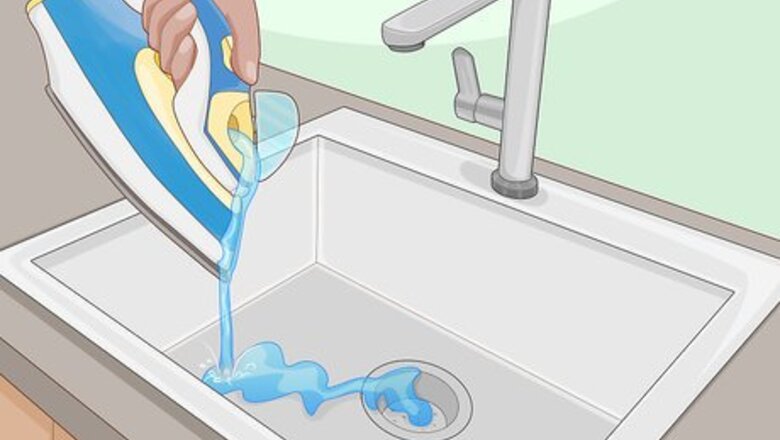
views
Ironing Stains out of Wood
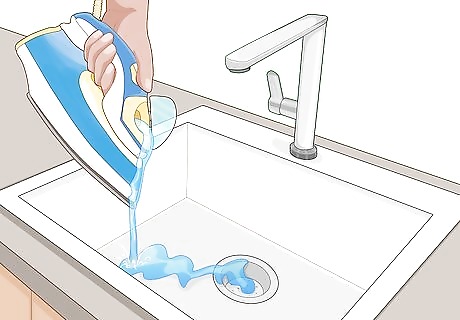
Drain all water out of your iron. Open the water cap on your iron by popping the top or twisting it counterclockwise until it’s all the way off. Take your iron to a sink and turn it over to empty out any water in the tank. Water is bad for wood and can cause it to rot, so you need to get all of the moisture out of your iron before you start.Tip: The iron will heat the moisture that is trapped inside of the wood and cause it to evaporate from inside the wood. This method won’t work if the stain is from anything other than water. If you can access the inside of the tank, wipe it down with a dry paper towel or cloth before reassembling it and putting it back into your iron. The sooner you can do this after the wood has been stained, the easier it will be to remove the stain. This method should be fine for any kind of wood. You can use a hair dryer instead if you don’t have an iron, but it will take much longer.

Stand the iron up and plug it in to preheat it. Lay an iron on the base and stand the plate up. Turn the dial on the iron to low and plug it in. Wait 5-10 minutes to let it preheat.
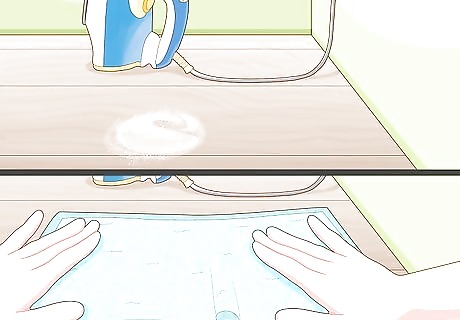
Lay cotton over the surface of the stain. You can use a shirt, cloth, towel, or rag. The thickness of the cotton will determine how long it takes to iron the stain out, but as long as it’s made of cotton, it doesn’t necessarily matter in terms of how effective it is.
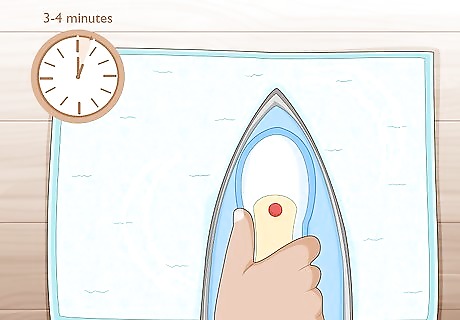
Apply the iron to the cotton and iron in a circular pattern. Once your iron is preheated, lay the plate flat on your cotton over the stained area. Begin to slowly move the iron around the stain in a circular pattern. Make sure that you iron at least 4–8 in (10–20 cm) around the stain in every direction. Iron for 3-4 minutes. Don’t let the iron just sit on one spot for more than 20-30 seconds or you’ll risk burning or warping the wood.
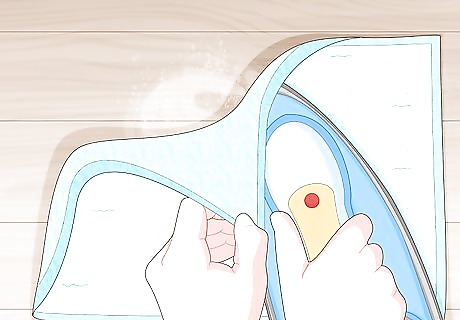
Lift the cotton and check the stain to see if you need to keep ironing. Grab the cotton by an unheated edge to avoid burning your hand. Pull the cotton up and inspect the stain to see if it is still there. If the stain is completely gone, you’re done.
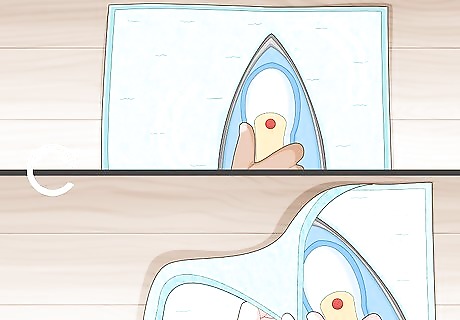
Repeat the process using the same cotton and iron to remove the stain. Use the same piece of cotton and the same iron on the same temperature to continue ironing the stain. Iron for another 4-6 minutes and repeat the process until the stain is gone. This process could take up to 30 minutes depending on how old the stain is.
Soaking the Surface in Mayonnaise
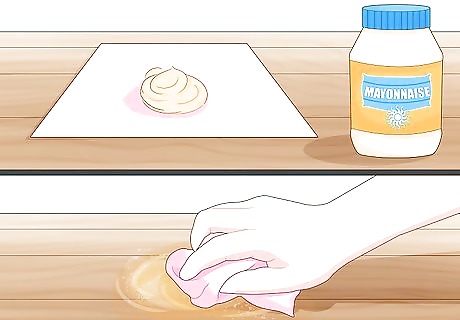
Scoop 1-2 tablespoons (15-30 grams) of mayonnaise into a clean towel and rub it into the cloth. Get a clean, cotton towel or dish rag and scoop some mayonnaise into the center. Hold the edges of the towel so that the mayo sits at the bottom of the towel and rub it into the fabric with your free hand from the other side. Mayonnaise contains eggs, oil, vinegar, and lemon juice. Most of these ingredients are included in furniture polishes and lacquers because they’re good at penetrating wood. The fat in the mayonnaise will absorb the moisture and leave your wood looking clean! If you don’t have access to mayonnaise, you can use petroleum jelly instead. Petroleum jelly may leave a weird texture behind after you clean it up though. Mayonnaise should be fine on any kind of wood. It may leave it smelling a little strange afterwards though.
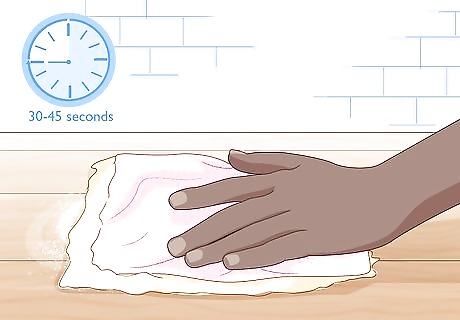
Rub the mayonnaise directly into the stain for 30-45 seconds. Unfold your towel and place the center over the stain. Rub the mayonnaise directly into the stained area using firm, circular strokes. Rub the wood and make sure that you cover each area of the stain.Tip: You won’t damage the wood by rubbing firmly, so don’t worry about hurting your wood.
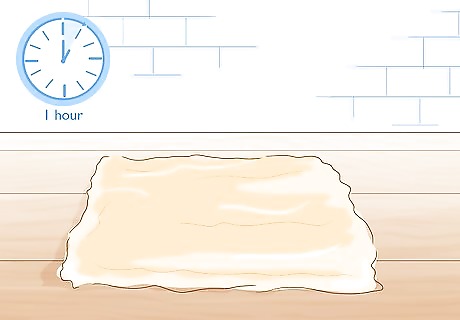
Let the mayonnaise soak into the stain for at least 1 hour. Lift your towel up without wiping the mayonnaise away and throw it in the washer or sink to clean it. One hour is the minimum amount of time that you should leave the mayonnaise on the wood. If you want maximum penetration into the wood or the stain is particularly old, leave the mayonnaise on the surface to let it soak overnight. The smell might be kind of funky if you leave the mayonnaise on overnight, but you won’t be damaging the wood.
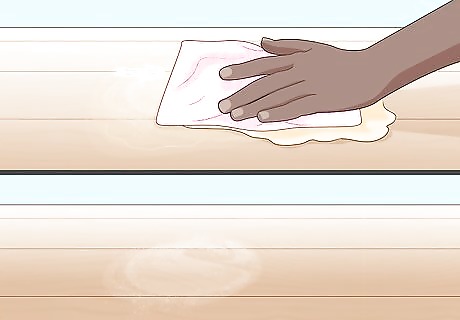
Wipe the mayonnaise up and inspect the stain to see if it’s gone. Get a clean cloth or rag and wipe up the mayonnaise. Check the stain to see if it is still there. You can use a damp cloth to wipe up any dried mayonnaise. Just make sure that you wipe the water and moisture off after you do this.
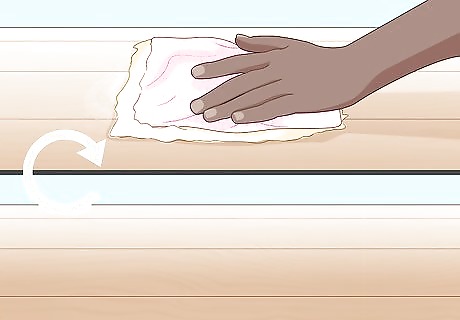
Apply another layer of mayonnaise if the stain isn’t gone. If the stain is only partially gone, apply another layer of mayonnaise and repeat the process. If it isn’t coming out of the wood, try using a different method to get the stain up. You may need to do this a few times to get the stain completely out.
Brushing Dark Stains with Toothpaste
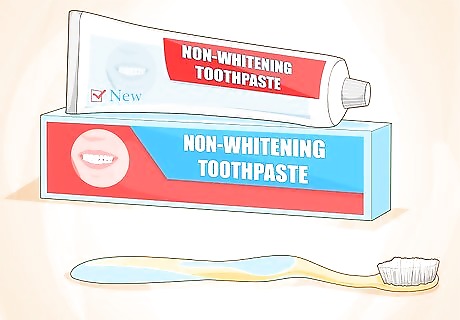
Get a non-gel and non-whitening toothpaste and a clean toothbrush. Gel toothpastes tend to be thinner and weaker, so they may not do as good a job at penetrating the wood. Whitening agents contain chemicals and additives that may not help you clean your stain. Use a clean toothbrush to clean water stains from wood.Tip: This is not the best option if your wood is antique, since the bristles on the brush could change the grain in older wood. This method works best if the stain is dark and your wood is lighter. Do not use toothpaste on antique wood. If you’re worried about damaging the grain of your wood, use a soft cloth instead of toothpaste.
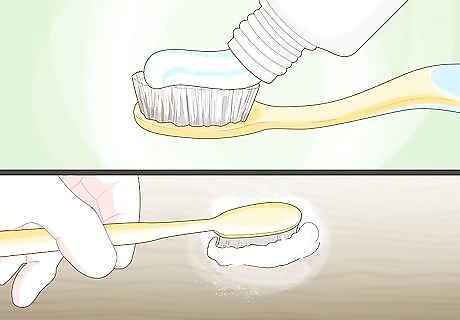
Fill your toothbrush with toothpaste and brush the stain. Load your toothbrush with toothpaste and start to scrub your stain using back-and-forth strokes. Work in the direction of the grain to effectively clean your wood. Brush each section at least 5-6 times to ensure that the toothpaste gets into the wood.
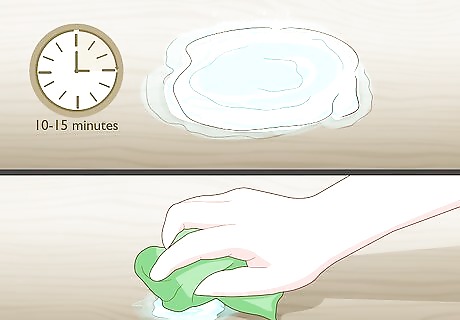
Let the toothpaste rest for 10-15 minutes and wipe it off. You don’t need to leave it on overnight or anything, but you do need to let the toothpaste sit for a couple of minutes after you’re done scrubbing. Wipe the toothpaste up with a dry paper towel. If you leave the toothpaste on for too long, you could discolor the wood.
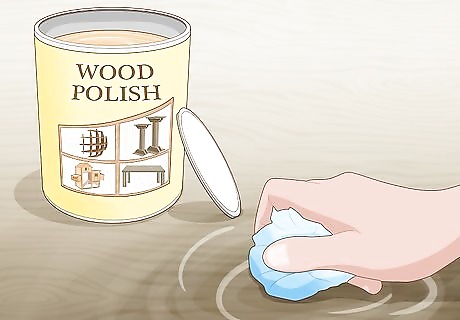
Polish the wood with a clear wood polish and soft cloth. After you’ve removed the toothpaste, check to see if the stain is gone. If it is, reseal your wood by using a wood polish. Spray some polish into a clean cloth and rub it into the wood. Wipe in the direction of the grain and let it air dry for 24 hours before you put anything on the wood. Follow the manufacturer’s directions by reading the label on your wood polish before applying it. Some polishes have specific directions that you need to follow. Use a clear polish so that you don’t change the color of your wood.
Using Abrasive Materials
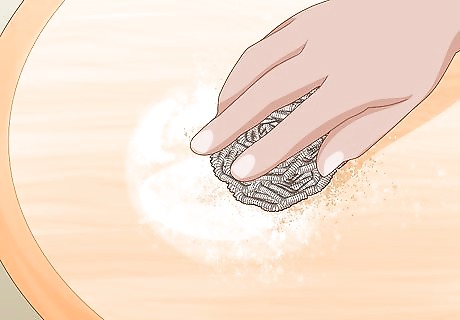
Scrape stains on finished wood away with extra-fine steel wool. Dip some steel wool in mineral oil. Scrape the stain in the direction of the wood grain. Go lightly at first to avoid ripping the wood up and try to only use the amount of pressure necessary to lift the stain out of the wood. Wipe excess oil off of the wood after the stain has disappeared by running a paper towel over the surface.Warning: This actually removes the finish from your wood. If you used a colored stain or lacquer to originally protect your wood, you may need to reapply it to keep the wood’s color consistent. It’s not a good idea to use abrasives on antique wood if you care about the value.

Strip layers off of unfinished wood with sandpaper. If the wood isn’t polished, finished, or stained, you can simply remove layers of your wood until the stained layers are gone. Start with a sheet of 120 grit sandpaper before stepping up to something coarser. Scrape the entire layer of the wood’s surface using back-and-forth strokes until the entire layer is gone. Wipe up wood shavings and dust with a dry cloth. You can use a belt sander if you want to remove stains from a larger surface and keep the pattern uniform. This will change the style and pattern of your grain.
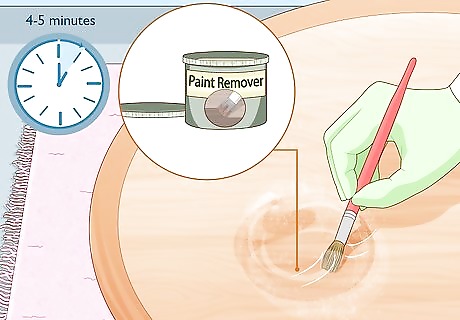
Use paint remover to get stains off of oak furniture. If your furniture is pure oak, you can use paint remover to lift it up. Put on some rubber gloves and fill a small cup or paint tray with paint remover. Dip a clean, natural brush in the paint remover and apply it to the stain by using back-and-forth strokes. Work in the direction of the grain. Use a clean rag to wipe it up after you’ve let it soak for 4-5 minutes. Try to avoid getting paint remover on the unstained areas of your wood. It may cause some discoloration if your wood is stained. To stiffen the paint remover, you can make a 1-part paint remover and 1-part 5% bleach combination. Apply the solution in the exact same way to remove your water stain.

















Comments
0 comment